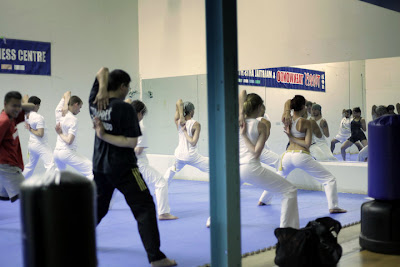A Lesson in Capoeira (PT. 1)
My lovely and cute (oops did i say that out loud?) co-worker Razmig talks to me about Capoeira everyday between the hours of 830am-430pm (M-F). To be honest, before Raz I knew nothing much about Capoeira. The only thing I knew was something that it originated in Brazil, and was done by cute Brazillian guys ...and some girls ...but to be fair, I assumed it was a sort of dancing ritual. Since I am a very curious person, always opening to trying and learning something new, I would interview Raz for my blog and, share the information with you.
LC-Laurely's Closet
R=Razmig (Raz)
LC: What is Capoeira?
R: Well Laurel, that cannot be answered in one sentence, so why don't i just email you the infrmation....Adapted from email:
Capoeira was created by African Slaves brought to Brazil from the continent of Africa, during the colonial period. Capoeira is a form of martial arts that grew from the will and need to survive. African slaves brought over from Angola, Congo and Mozambique, and with them, they brought their cultural traditions.
They hid their martial arts and traditions into a form of dance. The African people developed Capoeira not only to resist oppression, but also for the survival of their culture and the lifting of their spirits. After slavery, they continued to play capoeira. With no employment, many of them turned to gangs. Quickly capoeira was associated with crime and in 1892 became outlawed in Brazil. If a person was caught practicing the art, they were punished by cutting the tendons of the back of their feet. A rhythm, called cavalaria, was created as an alarm that warned them of the police. People that played Capoeira had nicknames to hide their identity from the police. Often they had more than one. Getting a nickname has become a tradition and people gained a nickname usually at a batizado.
Capoeira was against the law for 20 years until 1918. The first capoeira school ever to exist was that of Mestre Bimba. He was given permission to do so in 1937, after he demonstrated the art in front of president Getúlio Varga. Capoeira was finally recognized as a national sport.
There are two main styles of capoeira. Mestre Bimba is recognized as the father of Capoeira Regional. The second main style is Capoeira Angola, a slower and lower to the ground game retaining the rituals and traditions of capoeira.
The first school of Angola, Centro Esportivo de Capoeira Angola, was established by Mestre Pastinha in 1942. The school is located in the town of bahia.
Source: http://www.capoeirauniverse.com/capoeira_history.html
LC: What got you interested in Capoeria?
R: I grew up doing martial arts mostly Kung fu and animal styles at my Armenian community center. As a kid, I lacked the discipline, I had the heart but sometimes my mind would wonder, it was too much programming for me, then at the age of 16 I witnessed something that was unorthodox as a martial arts style something going against most of my previous training….Capoeira, it was self expression in the movements that I saw, the way kicks just flowed and everything was constantly moving, I soon learned stay still and you’re an easy target to your opponent, all throughout kung fu it was wait for the attack and counter, so it was very different.
LC: How often do you do it?
We train two classes per week usually ranging between 3 to 4 hours a class and then well have one music class per week about 2 hours long, but in my down time I throw kicks, cartwheels and freezes when ever I can.
LC-Laurely's Closet
R=Razmig (Raz)
LC: What is Capoeira?
R: Well Laurel, that cannot be answered in one sentence, so why don't i just email you the infrmation....Adapted from email:
Capoeira was created by African Slaves brought to Brazil from the continent of Africa, during the colonial period. Capoeira is a form of martial arts that grew from the will and need to survive. African slaves brought over from Angola, Congo and Mozambique, and with them, they brought their cultural traditions.
They hid their martial arts and traditions into a form of dance. The African people developed Capoeira not only to resist oppression, but also for the survival of their culture and the lifting of their spirits. After slavery, they continued to play capoeira. With no employment, many of them turned to gangs. Quickly capoeira was associated with crime and in 1892 became outlawed in Brazil. If a person was caught practicing the art, they were punished by cutting the tendons of the back of their feet. A rhythm, called cavalaria, was created as an alarm that warned them of the police. People that played Capoeira had nicknames to hide their identity from the police. Often they had more than one. Getting a nickname has become a tradition and people gained a nickname usually at a batizado.
Capoeira was against the law for 20 years until 1918. The first capoeira school ever to exist was that of Mestre Bimba. He was given permission to do so in 1937, after he demonstrated the art in front of president Getúlio Varga. Capoeira was finally recognized as a national sport.
There are two main styles of capoeira. Mestre Bimba is recognized as the father of Capoeira Regional. The second main style is Capoeira Angola, a slower and lower to the ground game retaining the rituals and traditions of capoeira.
The first school of Angola, Centro Esportivo de Capoeira Angola, was established by Mestre Pastinha in 1942. The school is located in the town of bahia.
Source: http://www.capoeirauniverse.com/capoeira_history.html
LC: What got you interested in Capoeria?
R: I grew up doing martial arts mostly Kung fu and animal styles at my Armenian community center. As a kid, I lacked the discipline, I had the heart but sometimes my mind would wonder, it was too much programming for me, then at the age of 16 I witnessed something that was unorthodox as a martial arts style something going against most of my previous training….Capoeira, it was self expression in the movements that I saw, the way kicks just flowed and everything was constantly moving, I soon learned stay still and you’re an easy target to your opponent, all throughout kung fu it was wait for the attack and counter, so it was very different.
LC: How often do you do it?
We train two classes per week usually ranging between 3 to 4 hours a class and then well have one music class per week about 2 hours long, but in my down time I throw kicks, cartwheels and freezes when ever I can.
 |
| A typical Capoeria class |
 |
| Atabaque drum-tradional African Drum used in Capoeria songs |


Comments
Post a Comment